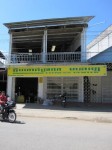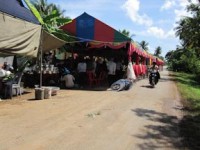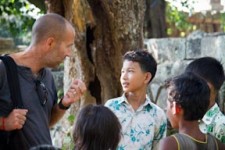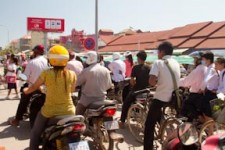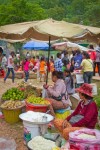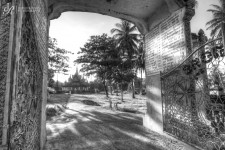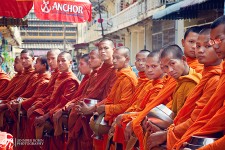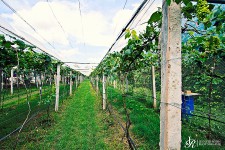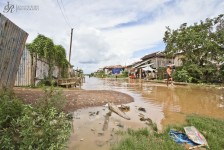When the Khmer Rouge seized power in 1975, the population of Cambodia was in the neighborhood of seven-and-a-half million people. The number of people who died over the next four years, until the Vietnamese invaded Cambodia and ended the Khmer Rouge genocide, varies from study to study; but most estimates point to the death of a quarter of the population. […]
Read About Cambodia
Between the two of us, Jen and I have traveled in a good number of countries and territories. Here is the listing: France, England, Germany, Italy, Spain, Turkey, Kuwait, Saudi Arabia, Iraq, South Korea, Japan, Okinawa, India, Thailand, Laos, Cambodia, Australia, Mexico, Costa Rica, the Virgin Islands, the Bahamas, and the Netherlands Antilles. Our collective travels in the United States include pretty much every state in the Lower Forty-Eight and all the Hawaiian Islands. Our activities in these destinations have been wide ranging, including SCUBA diving and snorkeling in Hawaii, California, the Caribbean, and Okinawa; sea kayaking expeditions along Mexico’s Baja Peninsula and through the Bahamas’ Exuma Cays; and backpacking trips in Yosemite National Park, on Australia’s Bibbulman Track, and in Costa Rica’s Corcovado National Park.
When we discuss these travels with other Americans, we are invariably asked which destination was our favorite. The questioner usually expects that our answer will be France or Spain or Italy or Australia or Hawaii or a Caribbean island, but none of these is the answer they receive. Instead, our answer is Cambodia.
Why Cambodia? Because all the things that define our ideal travel destination can be found there. Here are those things, in no particular order.
The Opportunity to Experience a Unique People and Culture
We believe travel should expose us to something new, something not American. Cambodia does this.
The vast majority of Khmers are rural and poor. They live in a world of water and emerald green, a collage of rice fields and forests and rivers and lakes and ponds. They live in simple wooden huts raised on stilts, in villages shared with dogs and chickens and pigs and cattle. Many still use water buffaloes to work their fields. They use car batteries to carry electricity to their huts. They fish and bathe and wash clothes in muddy ponds and streams, often doing all three at the same time.
On the Tonle Sap, the massive lake in northwestern Cambodia, there are floating villages. They have floating stores, floating mechanic shops, and floating diesel generators charging car batteries that bring electricity to floating homes. Many of these people are of Vietnamese descent. They live on one of the world’s largest fisheries, and their villages move with the seasonal rise and fall of the lake.
In small cities, the days start at a run. Women in business attire weave their motorbikes between potholes and cattle to reach jobs at banks and government offices. Laborers pile into trucks to work nearby fields. Children in uniforms play games and eat from hand-pushed food carts while waiting for schools to open their gates. People collect outside hospitals and eat from roadside stands before entering. The markets fill with vendors and shoppers. Monks walk the streets, collecting alms. Thousands of motorbikes, trucks, bicycles, and carts flow as rivers.
As the day warms, the pace of the city slows to a crawl. Tuk-tuk drivers sleep in hammocks and play board games with each other. Shopkeepers nap in their shops. The smell of the market’s meat and fish turns from bad to worse.
In the evening, city life becomes a relaxed stroll. Teenagers in their best Western jeans and shirts cruise the town on motorbikes. Ladies walk the riverfront in brightly colorful pajamas. Men pack open-air bars to drink and watch soccer games on televisions hooked to satellite dishes and car batteries. Small groups collect in public places for aerobics and martial arts classes. Children swim naked in fountains.
And through all of this, in every part of Cambodia, there is a constant noise. In the morning, it is singing birds, crowing roosters, and loudspeakers blaring chants from Buddhist temples. In the afternoon, it is barking dogs, squealing pigs, crying children, and loudspeakers blaring chants from Buddhist temples. At night, it is loud music, chirping geckos, buzzing cicadas, and loudspeakers blaring chants from Buddhist temples. All day long, it is the drone of motorbikes by the thousands, and loudspeakers blaring chants from Buddhist temples. In Cambodia, everything is alive and moving and making noise.
To experience these things is to experience something that is not America. Yes, Western culture has had its influence on Cambodia, and the signs of that influence are almost unavoidable; but it is still the culture of the Khmers, and it is not too difficult to see past the Americanisms.
A Friendly Populace
The Khmer people may be the friendliest we have ever met. They are almost universally approachable, helpful, and good-natured; and they are very interested in engaging with Americans.
In a small village near hilltop temple ruins, we ate lunch at an outdoor food stall. The woman who ran the stall spoke some English, and by then we spoke some Khmer. She helped us learn more as we ordered and ate, and she cooked us a special meal to accommodate our vegan diets. A Khmer man sat down at the table next to us. He also spoke some English, and he joined the discussion. We exchanged questions and answers and the stories of our lives. It was a sincere and warm exchange with curious and kind people. When we left, they addressed us as brother and sister, which is a customary way for Khmers to address their friends. Jen was particularly touched by this and recounts it often.
In another rural village, many miles down a potholed and rutted dirt road, we stopped our motorbike at a house with a vending stand. It was the typical setup for a roadside Khmer family trying to make some extra money: a rack of liter bottles filled with gasoline and an ice chest full of canned beer and water. We purchased two beers from the man who owned the house and walked across the road to sit on the ground by a tree. In a few minutes, a child brought us two chairs. We turned around to thank the owner and saw that the entire family had come outside to meet us. We left to a chorus of waves and smiles.
There was a young man working in a restaurant we frequented. We would talk with him when he waited on us, exchanging questions and answers and the stories of our lives. About the third time we met him, he wrote the following note on our bill: “Are you very kind. Please good health for you forever. And please good your travel in Cambodia. Please get my respect also. From me, Chhy.” I still have that bill.
These three anecdotes are typical of our interactions with the people of Cambodia. They are simple stories, and individually they are not particularly profound. Collectively, however, they are extraordinary; because they illustrate what we experienced every day, everywhere.
Reasonable Safety
If an American has heard anything of Cambodia, it has probably been negative: war, genocide, political instability, poverty. It is no surprise that those few Americans who have given any thought to Cambodia usually believe it is a dangerous place that should be avoided. It is an understandable conclusion, and it is wrong.
Despite a recent history that is exceptionally tragic, and an economy and political system that remain troubling, Cambodia is a very safe travel destination. That is our experience, and we believe it is shared by the vast majority of travelers. I would have no problem with one of my daughters traveling solo in Cambodia, and we have encountered several young Western women doing just that.
That is not to say that you can’t get into trouble in Cambodia. We are certain that you can. But the same can be said for any country, including the United States; and we suspect that your odds of getting into a tight spot are much higher in America’s big cities than they are in any part of Cambodia. Apply the same common sense and reasonable judgement that should be applied during a trip to Los Angeles or New York or New Orleans, and a traveler to Cambodia is unlikely to have a problem.
Low Cost
The more we spend to travel in a country, the less we enjoy it. There is simply nothing fun about spending hundreds of dollars a day for basic accommodations and food. This is not a concern in Cambodia, where a great deal can be experienced for very little money.
In the most expensive place we stayed in Cambodia, we were able to live in great accommodations, eat well, drink well, have our own motorbike, use a gym and a lap pool, and travel the countryside for under US $70 a day. That’s US $70 to pay for all of this for both of us. If we had stayed in one of the less-expensive guesthouses, we could have reduced our costs to US $50 a day, or less. There are very few countries where a traveling couple can live so large for so little.
Of course, you can spend a lot more in places like Siem Reap (the city adjacent the ruins at Angkor Wat) or Phnom Pehn (the nation’s capital). There are plenty of resort hotels at these destinations, and they are more than happy to charge you US $20 for a cheese sandwich. But you don’t have to spend that kind of money to live well in Cambodia. Even in Siem Reap, we stayed in a good accommodation, ate well, and had our own motorbike for under US $70 a day. In Cambodia, whether you spend a little or a lot is a matter of choice.
Access to Comfortable Accommodations
During our travels, we have developed criteria that define our idea of comfortable accommodations. There are seven.
1. It should be clean and bug-free. It should also be well-maintained, although worn-out and broken things are common in Cambodia and the rest of Southeast Asia, where people tend to keep using things until they break and are then slow to fix or replace them.
2. It should be large — about the size of the master bedroom suite in a middle-class, three-bedroom, two-bath, American home.
3. The bathroom should be of Western design, meaning there is a sit-down toilet, a sink that drains somewhere other than the bathroom floor, and a shower with its own stall. In other words, the bathroom should not be a water closet where the shower-head sprays onto the floor, and the sink drains onto the floor, and everything gets wet; and it shouldn’t have a squat toilet.
4. It should have a private patio or balcony, because we like sitting out at night to watch and listen to local life.
5. It should be quiet. This is a relative thing, as Cambodia is perhaps the noisiest place we have ever been. Motorbikes, monk chants, barking dogs, chirping birds, and loud music are part of the country’s sonic scenery. But we still don’t want to hear other guests through poorly-insulated walls, or children screaming and splashing in the swimming pool, or a late-night party on the hotel grounds.
6. Ideally, the accommodation is a detached cabin or bungalow.
7. It should have reliable internet access; ideally, it is accessible from inside the room. We write articles and post photographs when we are on the road, so good internet access is important to us. Every place we stayed in Cambodia had some form of internet access, even if it was spotty and only accessible from a common area. It was not always great, but getting internet access in Cambodia is still easier than getting internet access in Australia and some European countries.
Of the five hotels we used in Cambodia, one accommodation met all seven of these criteria, two accommodations met five, one accommodation met three, and the remaining accommodation met only one. All the accommodations met the most important criteria: clean and bug-free. Three of the five accommodations were of sufficient quality that we would use them again. One of the accommodations was a place we could live indefinitely.
Cambodian hotels did not always meet our ideal, but traveling the country did not require us to sleep on floor mats in bug-infested shacks. For a country still recovering from near-total destruction, the quality of offerings was surprising. You will not have great difficulty finding a reasonably-comfortable place to stay, and you are likely to come across a place that is truly great.
Access to Good Food
Jen and I are vegan — no meat, no fish, no milk products, no animal products of any kind. This can be a challenge in any country, particularly when you eat all your meals in restaurants. Cambodia is no exception, although it is easier than most Western countries. Perhaps it is more vegan-friendly because it is a Buddhist country, and Buddhism in its strictest form calls for a vegetarian diet. In actual practice, the average Cambodian Buddhist is not vegetarian; and Khmers consume all manner of fish, mammals, and birds. But the Buddhist background may make for a greater willingness to accommodate a vegan diet, and a greater number of dishes that can be made vegan with slight modifications. We never went hungry in Cambodia.
If you, too, are vegan or vegetarian, you will be able to eat well in Cambodia by knowing just a few Khmer phrases. They are included in the language chapter of this book. We did quite well by knowing how to say, “We eat Buddhist,” which Khmers understand as a vegetarian diet. Throw in the phrase, “No fish sauce,” and you have pretty much solved all the vegan and vegetarian challenges. The Khmer people are extremely kind, and they were almost always willing to adjust dishes to meet our requirements.
For those of you who are not vegan or vegetarian, a wide array of options will be available, with fish or meat as the centerpiece. You, too, will not go hungry. However, we still recommend that you consider a vegetarian diet during your travels in Southeast Asia, as eating local meats and fish increases your risk of contracting a food-borne illness. Both of us have had several bouts of traveler’s diarrhea, and we can only imagine how many more we would have contracted by eating meats and fish on the local economy. This may not be a great concern in an established restaurant that caters to Western tourists, but I wouldn’t touch meat from a roadside Cambodian food stand with a ten-foot pole.
All that said, we had no problems finding decent places to eat during our travels in Cambodia.
The Ability to Escape Commercial Tourism
It is not really possible to experience a country and its people from the grounds of a resort hotel or from the air-conditioned interior of a tour bus. In our travels, we make a conscious effort to avoid the commercial tourism industry. In the next chapter, we offer some thoughts on how to be a traveler as opposed to a tourist, including how to minimize the impact of tourism on your travel experience.
Cambodia’s commercial tourism industry is a major portion of the country’s economy, and it is growing rapidly. Siem Reap and the nearby Angkor Wat temple complex are visited by millions of tourists each year. Phnom Penh is home to thousands of Western expatriates and hosts its own swarm of foreign visitors. The coastal city of Sihanoukville is another area of concentrated tourism. Outside these major tourist destinations, however, there is still significant opportunity to travel without seeing many other Westerners. It is still possible to experience the people, the landscape, and the culture that is Cambodia. That kind of travel opportunity is a rarity.
Interesting Things to See and Do
Cambodia is one of the most interesting and entertaining countries we have visited. The entertainment is as easy to find as sitting outside at a corner restaurant and watching Khmer life go by. It is hard to describe how much fun we have had sitting on the balcony of our hotel room, drinking a beer, watching the evening procession of people and motorbikes, and listening to the hundreds of sounds that accompany Cambodian life.
Great entertainment can also be found in a simple motorbike ride through rural countryside and small villages. Children will wave and scream as you go by, and old men will smile and nod. Stop at a roadside stand for water or a beer, and you are almost guaranteed to have an interesting and fun interaction with someone.
And there are cultural and historical points of interest. There are ancient ruins to be seen throughout the country. There are the floating villages on the Tonle Sap. There are the remnants of the country’s conflicts and the Khmer Rouge era — they are sometimes hard to find, and sobering once found, but their historical interest and importance are undeniable.
But the most entertaining thing about Cambodia is still to be found in watching and getting to know the Khmer people. It beats the hell out of any amusement park, any day of the week.
Access to Your Own Transportation
Traveling means exploring, and it is not very easy to explore a place if you do not have your own transportation. In Cambodia, that means renting a motorbike — one of those things that are not quite moped and not quite motorcycle, and that are the prime mover of the Khmer people. We never had a problem acquiring a motorbike.
Later in this book, we devote a chapter to riding in Cambodia. For now, let’s just say that if you do not rent one, you are denying yourself much of the experience that Cambodia has to offer. Just getting on the road and learning to ride Khmer-style is entertaining. Beyond that, a motorbike enables you to explore areas few other travelers have seen, and to experience the fun of surprising a village with the first visit by a Westerner in anyone’s memory. And there is nothing quite as satisfying as getting the nod of approval from an old man, a veteran Khmer biker, who just watched you negotiate a field of knee-deep mud.
Good Weather
Our idea of good weather is warm weather. If it drops below 70-degrees Fahrenheit at any time of day or night, we start planning our escape. Cambodia stays nicely above 70-degrees and therefore meets our definition of good. If you like warm, humid weather, you will love Cambodia.
There is a wet season in Cambodia, which generally runs from May through October. We have been there during this time, during a wet season that was considered exceptionally wet. Never did the occasional rain storms significantly alter our plans. Instead, they benefited us by keeping the tourist population low. We will trade tourists for warm rain any day, and recommend that you keep an open mind about visiting Cambodia during the wet months.
Battambang Diary: Breaking a Sweat
Jen and I are exercise people. After months on the road without anything resembling an exercise program, both of us were feeling out of shape. Added to this was Jen’s ankle injury, which was two months old and still far from being healed. We needed a place to park for a while, rehabilitate the ankle, and get back some of […]
Battambang Diary: The Wedding Party
As I write this, we are in Andalusia, Spain; in a house in a rural area with no close neighbors; and the nearest village a small thing about a kilometer away, down a narrow, dirt road. At night, it is pitch black in the house. During the day, it is sunny. There are few, if any, cars that go past […]
Siem Reap and the Temples of Angkor, Cambodia
Siem Reap Battambang is a large town surrounded by rural farming areas. Siem Reap is a small city next to a large tourist attraction – the largest in Cambodia, and one of the largest in the world. In Battambang, it’s possible to be one of only a handful of tourists during the off-season. During the peak season, the tourist presence […]
Battambang Diary: A Primer for Motorbike Riding in Cambodia
One thing we have learned in our travels through Southeast Asia is that you really need you own wheels. That means renting a motorbike. In Cambodia, everyone and their sister owns a motorbike. They run from 100cc to 125cc in engine size, and lie somewhere between a moped and a dirt bike on the motorcycle spectrum. The degree to which […]
Battambang Diary: Bon Katen
Our Khmer language tutor, Khena, invited us to a Bon Katen at a Wat located a little over an hour’s motorbike ride east of Battambang. A Bon Katen is a celebration that raises donations for the Wat, or Buddhist temple complex. As we would discover, it’s a bit more than just that. Khena met us at our hotel at 8:00am […]
Battambang Diary: Wat Somrong Knong
The Buddhist temple complex of Wat Somrong Knong is located just a few kilometers north of Battamabang, and a little east of the Sangkar River. Part of the history of the Wat is that it was used by the Khmer Rouge as a prison; a place where people were interrogated, tortured, and executed during the Pol Pot regime. It is […]
Battambang, Cambodia
We spent several days in Battambang. It is a pleasant city, that is small enough to be called a town, yet big enough to have a wide selection of accommodations and places to eat. It is an easy town to get into and through, and the people are nice – as has been the case throughout our travels in Cambodia. […]
Cambodian Wine and Brandy: The Prasat Banan Winery, Battambang
There is a vineyard near Battambang, the Prasat Banan Winery. It is located south of Battambang, around kilometer marker 10 on Route 155, which is the road that travels along the west bank of the Stung Sangker River. We had a sampler of four of their products: a rose wine, a brandy, a non-alcoholic grape juice, and a non-alcoholic ginger […]
Cambodia: Kratie, Kompong Cham, and Kompong Chhnang
Crossing Into Cambodia We entered Cambodia by land at the Trapaeng Kriel border crossing with Laos. It was a fairly painless, although lengthy, process. From our hotel on the island of Don Khon in Laos, we purchased bus tickets through to Kratie, Cambodia. From all the signs we saw, it looks like through tickets can be purchased just about everywhere […]

